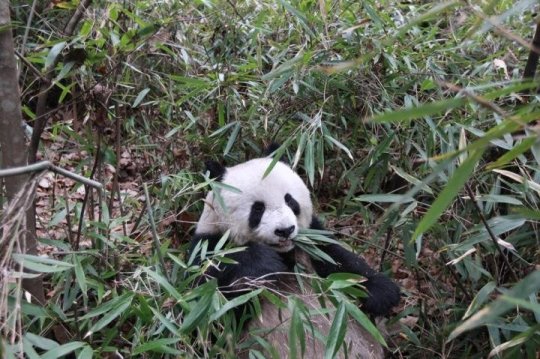[ad_1]
Giant pandas are unusual in being extremely specialized herbivores that feed almost exclusively on highly fibrous bamboo, despite belonging to a clade (Carnivora) of primarily flesh-eating carnivores. But a study reported in Current Biology on May 2 suggests that the switch to a restricted vegetarian diet wasn’t, in some respects, as big an evolutionary leap as it seems.
The study finds that the protein and carbohydrate content of the panda’s plant diet looks surprisingly like that of a hypercarnivore, animals that obtain more than 70 percent of their diet from other animals, they report. About 50 percent of the panda’s energy intake comes in the form of protein, placing them right alongside feral cats and wolves.
“As we know, the giant panda is a Carnivora species, yet extremely specialized on a plant food, the bamboo,” said Fuwen Wei of Chinese Academy of Sciences, Beijing. “Based on what they eat, they absolutely belong to the herbivores, but considering the macronutrient composition of the ingested and absorbed diets, they belong to the carnivores.”
The pandas do have traits in common with herbivores, including a skull, jaw musculature, and dentition that are adapted for fibrous diets, and a specialized “pseudo-thumb” used for handling bamboo. They’ve also lost the ability to taste umami, which is often associated with meat eating. On the other hand, giant pandas have a digestive tract, digestive enzymes, and gut microbes that resemble that of carnivores and not herbivores.
In the new study, Wei teamed up with nutritional ecologist David Raubenheimer from the University of Sydney and colleagues to explore the macronutrient composition of their diet, including what the pandas ingest and what they absorb. Using an approach called nutritional geometry, the team showed that the macronutrient mix that giant pandas both eat and absorb is similar to carnivores, and unlike herbivores. The macronutrient composition of the panda’s milk also places it squarely among other carnivores.
The researchers say the findings can help resolve long-standing questions concerning the evolution of the giant panda, including the unusual transition to extreme specialized herbivory by a member of a carnivorous clade. “In fact,” they write, “the transition was likely more superficial than assumed, combining substantial adaptation to new food types with relatively smaller changes in macronutrient handling.”
The herbivorous diet led to evolutionary adaptations in their teeth, skull, and pseudo-thumb needed to process bamboo. But their gut and digestive system changed little, suggesting minimal evolutionary modification from their ancestral state was needed to deal with the macronutritional properties of bamboo. Their short gut, together with the abundance of bamboo, allows the panda to consume and process large amounts of bamboo, compensating for the low digestive efficiency of such a fibrous diet.
“There is also a broader message from this study,” says Raubenheimer. “It demonstrates the importance of considering both foods and nutrients in understanding the evolutionary ecology of animals. This is what nutritional geometry is designed to do.”
Wei says they will continue to study the evolution and adaptation of the giant panda. They’ll also apply that work to the panda’s conservation management as an endangered species.
Story Source:
Materials provided by Cell Press. Note: Content may be edited for style and length.
[ad_2]















